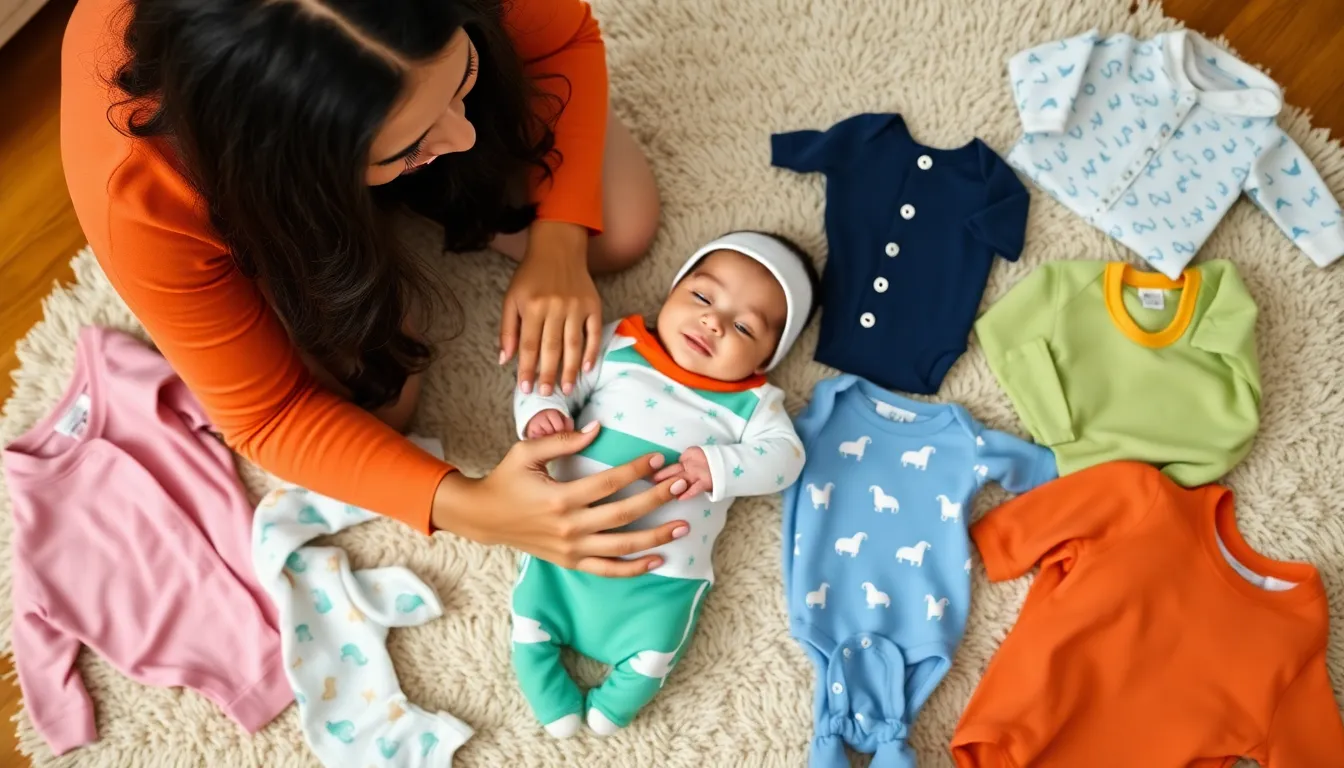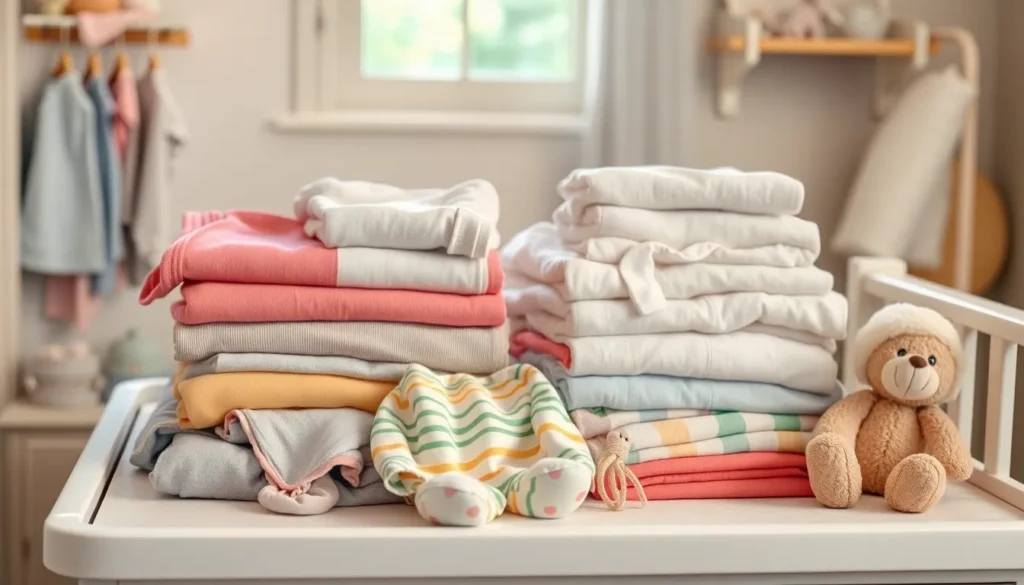Table of Contents
ToggleWhen it comes to dressing a newborn, parents often find themselves in a whirlwind of choices. With tiny socks that could double as finger puppets and onesies that seem to have more snaps than a spaceship, picking the right baby clothes can feel like an Olympic sport. But fear not! The quest for the best baby gear is not just about style; it’s about comfort, practicality, and a dash of cuteness that’ll make anyone swoon.
What Baby Clothes Are Best For Newborns?
Selecting the best baby clothes for newborns involves focusing on comfort, practicality, and style. Soft fabrics like cotton are essential since they ensure comfort against a baby’s sensitive skin. Prioritizing onesies and bodysuits is advisable as they provide easy access for diaper changes.
Layering options like sleep sacks and blankets keep newborns warm while allowing for flexibility. Features such as snap closures and elastic openings simplify dressing and undressing, reducing fuss for both the baby and parents.
Footed pajamas remain popular due to their warmth and convenience. Pants with elastic waistbands fit snugly while allowing for movement. Items that offer stretchy necklines make it easier to dress infants without causing discomfort.
Consider the season when choosing clothing; lightweight materials work best for warmer months, while thicker fabrics are beneficial during colder months. Staying mindful of sizes is key; opt for clothing sizes that allow for growth, ensuring longer use.
Keep in mind that colors and patterns add personality, but practicality should always come first. Ensuring that baby clothes are easily washable helps maintain cleanliness without added stress. Consistency in choosing designs helps in quick outfit changes, particularly during unpredictable moments.
Evaluating these aspects allows parents to curate a functional yet stylish wardrobe for their newborns, balancing aesthetics with comfort and ease.
Types of Baby Clothes

Choosing the right types of baby clothes plays a crucial role in ensuring comfort and ease for newborns. Various options cater to different needs, allowing parents to make informed choices.
Onesies
Onesies serve as essential staples for a newborn’s wardrobe. They facilitate quick diaper changes due to convenient snap closures. Soft fabrics like cotton provide a gentle touch against sensitive skin. Versatile in design, they come in short and long sleeves, suitable for varying temperatures. Layers can easily be added for extra warmth, making onesies practical year-round. Multiple colors and patterns offer visual appeal while maintaining comfort as a top priority.
Sleepers
Sleepers are designed for maximum coziness during sleep. They cover the entire body, offering warmth in cooler climates. Zip or snap front openings make dressing and undressing simpler for parents. Many options include footed designs that eliminate the need for socks, enhancing comfort. Comfortable fabrics ensure babies stay snug throughout the night. Sleepers combine function and style, making them a preferred choice for bedtime.
Swaddles
Swaddles provide security, mimicking the womb’s snugness. Parents use these to wrap newborns, promoting deeper sleep with fewer disturbances. Soft, breathable materials keep babies comfortable without overheating. Some swaddles feature Velcro or zipper closures for easy securing and adjusting. Utilizing swaddles helps establish a calming bedtime routine, which can be beneficial for both child and parent. Different sizes and designs accommodate growth and preferences, ensuring ongoing use and comfort.
Fabrics to Consider
Selecting the right fabrics for newborn clothing significantly impacts comfort and safety. Parents must prioritize softness and breathability to ensure their baby stays cozy.
Softness and Breathability
Fabrics like cotton stand out for newborns due to their gentle touch against sensitive skin. Cotton allows for breathability, preventing overheating during sleep. Linen and bamboo also offer excellent options, providing a cool feel while allowing air circulation. Natural fabrics generally outmatch synthetic materials in softness, making them ideal for delicate skin. Choosing lightweight fabrics aids in regulating body temperature, ensuring babies remain comfortable year-round.
Safety and Non-Toxicity
Safety remains a top concern when choosing baby clothes. Selecting fabrics certified as free from harmful chemicals contributes to a safer environment. Organic cotton garments present a reliable option, offering non-toxic alternatives that minimize skin irritation. Avoiding materials that undergo extensive chemical processing helps reduce exposure to irritants. Ensuring that dyes and finishes are environmentally friendly promotes an overall safer fabric choice. Non-toxic fabrics help protect newborns’ sensitive skin from allergies and rashes, making safety a paramount factor in selection.
Essential Features
Newborn clothing features should prioritize comfort, convenience, and safety. Each attribute significantly impacts a baby’s well-being.
Ease of Dressing
Snap closures make dressing easier, especially during diaper changes. Parents appreciate designs that open wide, allowing quick access. Zippers can simplify the dressing process, while stretchable necklines offer added convenience. Clothing that slips on easily reduces fuss during outfit changes. Consider fabric types that provide softness against delicate skin while being sturdy enough for daily use. Ease of dressing helps parents manage hectic schedules.
Adjustability and Growth
Clothing must accommodate a newborn’s rapid growth. Adjustable elements like fold-down cuffs can extend the life of outfits. Fabrics with a bit of stretch allow for movement as babies grow. Consider buying items that come in multiple sizes or have adjustable features. Opting for garments that can transition from one stage to another maximizes utility and reduces expenses. Adjustable details ensure that clothes remain comfortable and practical throughout the growth stages.
Tips for Choosing the Right Size
Selecting the correct size for newborn clothing is essential for comfort and practicality. Knowing your baby’s weight and length prior to shopping simplifies the process significantly. Most brands offer size charts based on these measurements, making it easier to find the perfect fit.
Consider the growth rate of newborns, as they can gain weight quickly in those first few weeks. Choosing clothes labeled for a specific age range, like 0-3 months, accommodates this growth while providing wearability during those early stages. Look for clothing items with adjustable features, such as snap closures and elastic waistbands.
Prioritize clothing designed for easy layering. Layering adds warmth and flexibility, allowing parents to adapt outfits according to changing temperatures. Opt for pieces with room for movement, enabling infants to stretch and kick comfortably.
Understand that different brands may have varying sizing standards. Trying on different brands can help identify which ones provide the best fit for your baby. Select clothing that allows for a couple of inches of extra room to ensure longevity.
Evaluate the cut and style of baby clothes. Some styles may fit differently, impacting how snugly they sit around arms and legs. Avoid overly tight clothing, prioritizing freedom of movement instead.
Lastly, remember that softness and comfort remain critical when investing in baby’s first wardrobe. Fabrics that are gentle against sensitive skin keep newborns happy. With the right size and comfortable materials, finding the perfect outfits for newborns becomes a delightful experience.
Selecting the right clothes for newborns is essential for ensuring their comfort and well-being. Prioritizing soft fabrics and practical designs helps parents navigate the overwhelming choices available. By focusing on items like onesies and sleepers that cater to ease of dressing and diaper changes, parents can create a functional wardrobe.
It’s crucial to consider adjustability and safety features, which support a baby’s rapid growth and protect sensitive skin. With a thoughtful approach to fabric selection and sizing, parents can build a stylish yet practical collection of baby clothes. Ultimately, striking a balance between comfort, convenience, and aesthetics will lead to a positive experience for both parents and their little ones.





